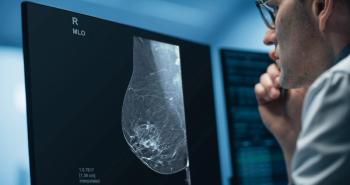
Infrared Thermography Fails in Breast Cancer Screening
The non-radiation based imaging modality is not a reliable breast cancer screening tool and mammography should remain the standard of care.
Infrared thermography is not a reliable breast cancer screening tool and mammography should remain the standard of care, researchers said last week at the
Researchers from Bryn Mawr Hospital in Boston evaluated the effectiveness of infrared thermography as a screening tool. Infrared thermography is a non-radiation based imaging modality that measures thermal abnormalities in breast tissue.
“Today, large numbers of patients are requesting breast imaging exams that do not involve radiation and inquiring about thermography in particular,” said one of the researchers Cara Marie Guilfoyle, MD, a breast fellow.
Researchers examined 178 patients. After having abnormal mammography, ultrasound, or MRI findings, the patients were scanned using the No Touch Breast Scan (NTBS) infrared thermography system prior to undergoing a minimally invasive biopsy. The scan results were then compared with pathology findings.
“In our study, the NTBS high specificity mode missed 50 percent of all cancers, while the high sensitivity mode delivered an unacceptable number of false positives,” Guilfoyle said.
In the high specificity mode, of the 52 patients later identified with cancer, infrared imaging failed to pick up 26 (sensitivity 50 percent). Sensitivity was lower with early-stage ductal carcinoma in situ than with invasive cancer. Of the 132 negative biopsies, 42 presented with positive findings on infrared (specificity 67 percent). The positive predictive value of infrared thermography was only 37 percent, while the negative predictive value was 77 percent.
When the high sensitivity mode was used, the scan correctly identified 44 of the 46 positive breast biopsies (sensitivity 87 percent). Of the 116 negative biopsies, 61 were incorrectly identified as positive (specificity 48 percent). Twenty-two patients were excluded due to uninterpretable thermography scans. Overall, the positive predictive value of infrared thermography was 40 percent, while the negative predictive value was 90 percent. No significant difference was found in sensitivity between invasive and in situ cancers.
Lead researcher Andrea Barrio, MD, FACS, a breast surgeon at Bryn Mawr Hospital, said that few studies have evaluated the usefulness of infrared thermography and the findings are confusing. Some research found the technology to be more accurate in detecting cancer, but patient populations examined may have been significantly different.
“Certainly, these findings fail to point out a useful role for infrared thermography in our patient population,” Barrio said. “Our research shows infrared thermography cannot be used as a successful adjunct to mammography nor can it replace any of the screening modalities in standard practice today. Mammography remains the gold standard.”
Newsletter
Stay at the forefront of radiology with the Diagnostic Imaging newsletter, delivering the latest news, clinical insights, and imaging advancements for today’s radiologists.




























